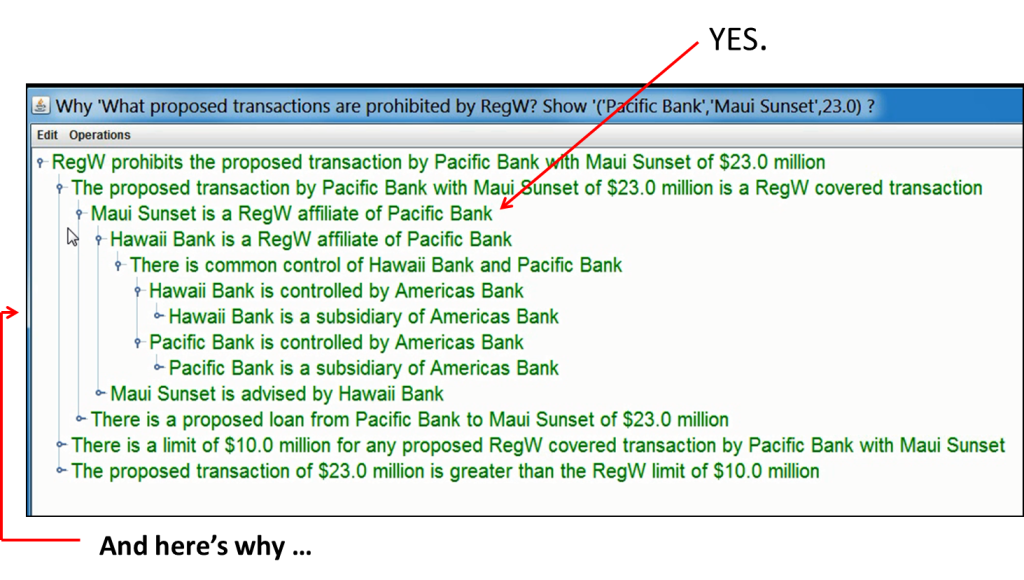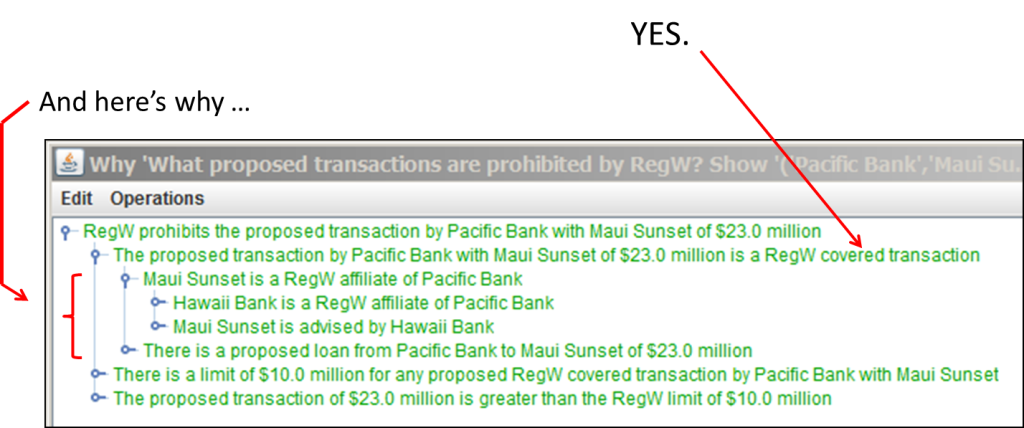Demo – Ergo for Financial Regulatory Compliance
Note: the video above includes an introduction and overview, case study begins at 6:27, Ergo execution of the demo at 10:00. See below for more details on the RegW case study.
Automated decision support for financial regulatory and policy compliance
A complex set of regulations and associated policies govern a wide range of operations and activities that financial institutions, such as banks and investment firms, engage in every day. Compliance, and proof of compliance, are essential: for both external regulators and internal management. The complexity and amount of regulations and related policies are ever-growing. The stakes are high: the global financial crisis of 2008 cost the overall economy trillions of dollars while individual institutions spent over 100 billion dollars on fines, penalties, and legal settlements [1]. To mitigate the probability and severity of another financial crisis, the US and many other advanced industrial countries enacted a broad range of new regulations and policies including the Dodd-Frank Act. Additional regulations, along with associated policies, are continuously being developed and issued, and likely will continue for many years to come.
Automated support for such regulatory/policy compliance is desperately needed. But current methods are expensive, unwieldy, and have a very high false positive rate for suspicious transaction alerts – leading to long hours of wasted time and effort by compliance officers who must follow up each alert.
Ergo Meets the Needs
“The concept of ontology and common language is gaining traction everywhere. It’s gaining traction at the right level for the right people. But when you combine common language with executable business rules you really start to understand the potential of inference based processing. So I’m going to ask you to pay close attention, this is what the future of linked risk analysis is going to look like.” — Mike Atkin, Managing Director of the EDM Council (leading financial industry consortium), discussing the EDMC sponsored FIBO PoC for Regulation W in which Coherent and Ergo played a leading role.
Coherent offers a new approach. We start with the natural language source sentences in published regulations and other documents. We encode each sentence into the Ergo language as a logical statement and add any necessary background knowledge. These statements are now available for deep reasoning to answer queries, make decisions, and trigger actions, via Ergo’s powerful reasoning engine. Essentially, the policy document itself is transformed into a set of executable business rules that can then be applied to analyze streams of financial transactions and other operational data. Alerts generated from the use of these rules can provide explanations in English — an audit trail, with the logical chain of reasoning that led to the alert being issued. Accuracy is high and compliance officers (without training in logic or programming) can understand easily why an alert was issued and which policies or regulations were violated. Adding new rules and updating existing ones is straightforward and fast, with subject matter experts in a closer loop than with existing methods. It’s even possible to resolve conflicts between rules and to customize rules to particular geographic areas or business units. What-If scenarios can be constructed to analyze the impact of new regulations and policies. Graph databases (RDF), relational databases, spreadsheets, existing ontologies in OWL, and other kinds of relevant knowledge, can be imported, mapped, and integrated tightly into overall reasoning.
Ergo is flexibly deployable. Together with the knowledge bases, it can be fully integrated into an overall compliance product, service, or enterprise application, in multiple ways. It can be queried, started or stopped, loaded, and configured via its Java API.
Talk to us about using Ergo for your regulatory or policy needs.
Case Study: Regulation W |
During June 2013 to June 2014, Coherent worked with the Enterprise Data Management Council (EDMC), a leading financial-sector international industry-government consortium, on an overall application-pilot proof-of-concept (PoC) effort targeting decision automation for financial regulations. Coherent’s CTO and CEO Benjamin Grosof was the technical lead for the PoC which included Wells Fargo Bank, SRI International, and the Governance, Risk and Compliance Technology Centre (GRCTC, Ireland). The PoC included leveraging EDMC’s FIBO (the Financial Industry Business Ontology), an emerging ‘common language’ for automation of business processes across the financial industry to create semantic business rules capable of deep reasoning. The PoC very successfully reached its goal of demonstrating how compliance with a representative subset of the US Federal Reserve Regulation W (Reg W) could be automated. We showed how various suspicious transactions prompted alerts and then provided automated explanations in English giving the justification for the particular alert.
Coherent’s CTO, Benjamin Grosof gives a video demonstration of the PoC.
Note: the video above includes an introduction and overview, case study begins at 6:27, Ergo execution of the demo at 10:00.
Contact us for a live demo presentation.
Reg W regulates and limits the dollar amount of transactions that can occur between banks and their affiliates. It was designed to limit risks to individual banks and to the financial system as a whole.
We started with the text of Regulation W as written in the Federal Reserve, Electronic Code of Federal Regulations e-CFR Title 12 -> Chapter II -> Subchapter A -> Part 223.
We created a knowledge and rule base to capture the regulatory rules, queries and underlying facts in a simulated example.
Using this knowledge base we were able to ask queries, such as the following:
Clicking ‘Why’ leads to a Justification Window:
User clicks the handles to expand the explanations:
To as much detail as the user desires:
Here’s how the pilot answered three key questions:
- Is the transaction’s counterparty an affiliate of the bank?
- Is the transaction contemplated a covered transaction?
- Is the amount of the transaction permitted?
For more details and examples of the rulebase, see the presentation: http://coherentknowledge.com/wp-content/uploads/2014/08/SemTech-2014-presentation-final.pdf and the paper: http://coherentknowledge.com/wp-content/uploads/2013/05/rulelog-industry-paper-ruleml2015.pdf and other material at: http://coherentknowledge.com/publications/#finance
[1] Banks pay out $100bn in US fines by R. McGregor and A. Stanley, Financial Times, March 25, 2014.








